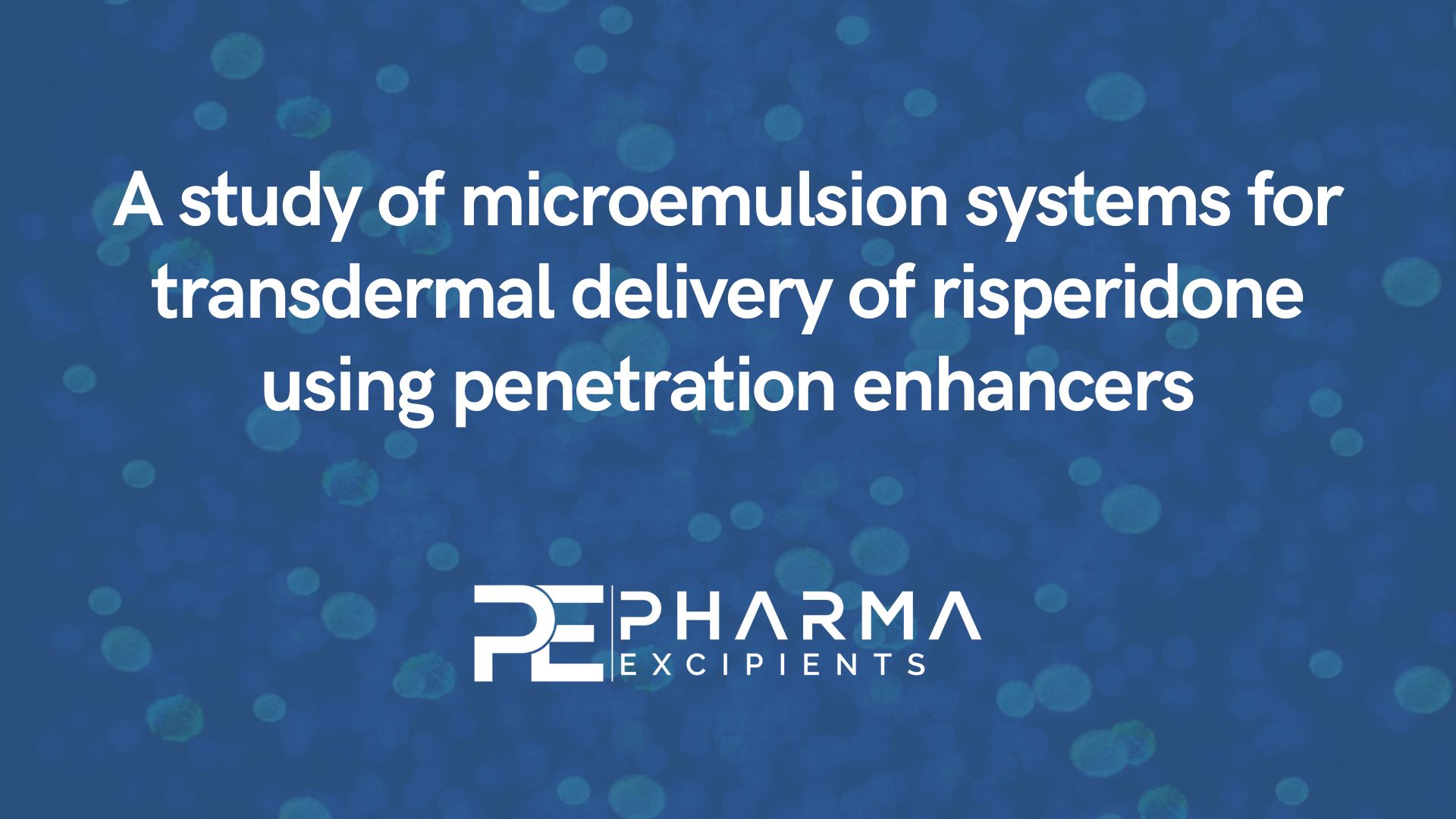A study of microemulsion systems for transdermal delivery of risperidone using penetration enhancers

Abstract
The aim of this study was to develop and characterize microemulsion formulations using penetration enhancers as potential transdermal delivery systems for risperidone. Initially, a simple formulation of risperidone in Propylene Glycol (PG) was prepared as a control formulation, together with formulations incorporating various penetration enhancers, alone and/or in combination, and also microemulsion formulations with various chemical penetration enhancers, were prepared and all were evaluated for risperidone transdermal delivery. An ex-vivo permeation study was carried out using human cadaver skin and vertical glass Franz diffusion cells to compare all the microemulsion formulations. The microemulsion prepared from oleic acid as the oil (15%), Tween 80 (15%) as the surfactant and isopropyl alcohol (20%) as the co-surfactant, and water (50%) showed higher permeation with a flux value of 32.50±3.60 ug/hr/sq.cm, a globule size of 2.96±0.01 nm, a polydispersity index of 0.33±0.02 and pH of 4.95. This novel in vitro research disclosed that an optimized microemulsion formulated using penetration enhancers was able to increase permeation of risperidone by 14-fold compared to the control formulation. The data suggested that microemulsions may be useful in the delivery of risperidone via the transdermal route.
Introduction
Risperidone is an antipsychotic drug often administered orally in schizophrenic and bipolar disorder patients. It is a benzisoxazole derivative that selectively antagonizes serotonin and to lesser extent dopamine via the 5-Hydroxytryptamine (5-H2A) and Dopamine D2 receptor.1, 2, 3 Oral risperidone has visibly shown to reduce various symptoms associated with manic disorder and schizophrenia. Risperidone is a poorly soluble drug, but it has high permeability, it is classified as a BCS class II active as per the Biopharmaceutical Classification System. The molecular weight and log p value of risperidone is 410.5 g/mol and 2.5 respectively. One of the significant downsides related with risperidone treatment is having low bioavailability when orally administered risperidone gets metabolized by cytochrome P-450 enzyme during first pass metabolism.4, 5, 6 Risperidone is well absorbed with 70% bioavailability following oral administration.7 The transdermal route is feasible to overcome drawback of oral administration such as low bioavailability.
Human skin is the outermost part and the largest organ of the human body which makes it an appealing, efficacious, innovative and easily accessible route for therapeutic drug delivery.8 This skin system has its unique morphology of each layer as well as characteristics and is designed naturally in such a way that keeps our insides in and outsides out.9, 10 Due to the barrier property of the stratum corneum (SC), the delivery of pharmaceutical drugs through skin becomes challenging. To achieve the maximum therapeutic effect of a drug, a drug is required to cross this ‘exogenous-substance-resistance’ barrier offered by SC and infiltrate through the skin to underlying tissues and circulate without accumulating in skin layers.11, 12 Various approaches are considered and extensively studied to overcome remarkable barrier properties temporarily and safely, and thus improving drug’s permeability through the skin. One widely used and long-lasting approach is an addition of penetration enhancers into the formulation.13, 14 Penetration enhancers are also known as permeation enhancers, sorption promoters and accelerants.10, 14 Penetration enhancers are chemical components and/or physical procedures that reversibly decreases skin’s barrier property and increase the drug passage through skin and thus contribute to increased permeability. Due to its specific mode of action on the SC, penetration enhancers influence drug diffusion or alter partitioning in SC for drug to pass through Penetration enhancers are broadly classified based on the technique as physical enhancers and chemical enhancers. Physical penetration enhancers use a mechanical concept to create a low resistance pathway for drug transportation while chemical enhancers use the chemical concept to facilitate drug permeation to dermis layers. The chemical enhancer such as Kolliphor CS 20 is able to increase permeation of Econazole Nitrate through the nail.15 Chemical penetration enhancers exhibit properties of being non-toxic, colorless, pharmacologically inert substance and odorless. The most widely known chemical penetration enhancers include fatty acids, alkanes, esters, terpenes, cyclodextrins, surfactants, and azone (laurocapram). The advantage of using chemical penetration enhancers is increase the bioavailability of drug by increasing permeation of drug through the skin, the cost and complexity is less than physical penetration enhancers and a combination or mixing is possible to create even more potent penetration enhancer.16, 17
Microemulsions (ME) are thermodynamically stable mixtures of oil, water, and surfactant.18, 19, 20 These transparent formulations are commonly prepared using low-energy methods like spontaneous emulsification (SE), phase inversion temperature (PIT) and phase inversion composition (PIC). These methodologies involve spontaneous formation of droplets at oil and aqueous phase interface. The characteristics of these formulations depend on the solubility, hydrophilic and lipophilic properties of the surfactants used.21, 22 The particle size of these formulation is usually less than 100 nm. There are three different types of microemulsions 1) water in oil (W/O), water is inner phase and oil is outer phase 2) Oil in water (O/W), oil is inner phase and water is outer phase 3) Bi-continuous emulsion, both oil and water phase act as inner and outer phase.23, 24, 25 In recent years, microemulsion formulation is the most studied system for potential transdermal drug delivery routes.26, 27, 28, 29, 30 The components of microemulsion act as penetration enhancers when applied topically by reducing skin barrier effect temporarily and promoting drug transport across the skin. The microemulsion system acts as a potential carrier for hydrophilic and lipophilic drugs by increasing solubility and bioavailability.31, 32To address the solubility problems and enhance bioavailability, formulation scientists have turned to formulation techniques such as, but not limited to, nano suspension, orodispersible films, amorphous solid dispersion, Solid lipid nanoparticle, emulsion, emulsomes, and nanoparticles.33, 34, 35, 36, 37, 38 The microemulsion system are easy-to-prepare, have long stability and widely used for pharmaceutical use.39 Microemulsion is ideal for drug delivery via the ocular, vaginal, pulmonary, dental, and topical channels in addition to the oral and intravenous routes.40 The microemulsion system with high drug load penetrates through skin, dragging the drug with it, increasing the drug partition in the skin layer and permeation of the drug.28, 41 The oil phase and surfactant phase increase the permeation by modifying the stratum corneum barrier property and by increasing the drug solubility in formulation. A water component of microemulsion causes the hydration of the outer layer of stratum corneum which leads to absorption of drug and increase permeation of the drug. Thus, reversible and temporary change in stratum corneum structure allows the drug molecules to pass. Another benefit of microemulsion with smaller droplet size range stimulates permeation across the skin barrier. Furthermore, the permeation activity of the microemulsion system can be enhanced by selecting suitable enhancers such as oil, surfactant and co-surfactant to achieve synergistic effect from individual components. A selection of penetration enhancers was carried out based on dual functional role as penetration enhancer as well as microemulsion ingredient. Oleic acid (OA) was selected as a penetration enhancer which also, act as oil phase in the preparation of microemulsion. Tween 80 (T80) acts as a penetration enhancer as well as surfactant in microemulsion preparation. Transcutol® P (TRC) and Isopropyl Alcohol (IPA) were selected as penetration enhancers as well as cosurfactant in microemulsion preparation.
In this study, we have performed solubility study of risperidone in various chemical penetration enhancers and investigated the effect of various chemical penetration enhancers on the transdermal delivery of risperidone. The microemulsion formulations were prepared using selected penetration enhancers. The selection of microemulsion components were based on its solubilization capacity and enhanced permeation activity. Microemulsions were evaluated for in-vitro skin permeation. The optimized microemulsion were tested to conform stability over the time. The long-term goal of our study is to develop a new risperidone formulation for transdermal route of administration to treat schizophrenia and bipolar disorder.
Read more here
Materials
The drug substance was Risperidone (RIS), which was obtained from Teva Pharmaceutical Industries Ltd. in Israel. Oleic Acid (OA), Tween 80 (T80), Isopropyl Alcohol (IPA) and Transcutol® P (TRC) were investigated as chemical penetration enhancers. Gattefosse Corporation, Paramus, NJ, USA, provided Transcutol® P (TRC) and Labrasol (LS) as a gif samples for research. Cineol (Cin), HPLC grade Methanol and Water, Propylene Glycol (PG), Tween 80 (T80), Isopropyl Myristate (IPM), Isopropyl Alcohol.
Amitkumar Virani, Nirali Dholaria, Namrata Matharoo, Bozena Michniak-Kohn, A study of microemulsion systems for transdermal delivery of risperidone using penetration enhancers, Journal of Pharmaceutical Sciences, 2023, ISSN 0022-3549, https://doi.org/10.1016/j.xphs.2023.07.007.
Watch the webinar “BASF & Catalent: Optimizing Lipid-Based Formulation For Commercial Success” here:


